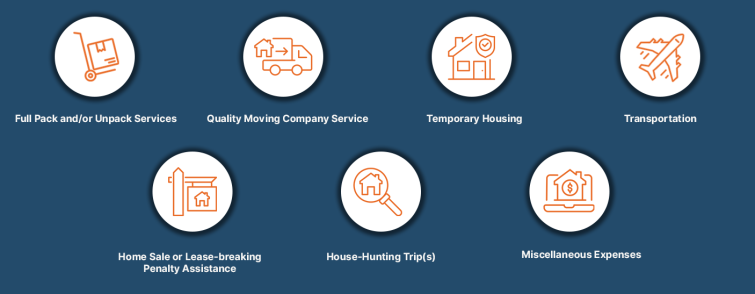How Much Is The Average Relocation Package in 2025?

Relocating employees can be a significant investment for any business, with costs varying widely based on several factors. Notably, relocating current employees often proves more expensive than onboarding new hires. Understanding these cost dynamics is crucial for designing effective relocation packages that align with both your employees’ needs and your company’s budget. In this blog, we’ll explore essential tips and strategies for creating the best employee relocation packages, ensuring a smooth and cost-effective transition for your workforce.
Keep reading to learn how to optimize your relocation process and support your employees every step of the way.
There is no straightforward answer to which job relocation expenses a company will cover. The extent to which a company foots the job relocation services bill significantly varies. Several key factors impact corporate relocation spending, including:
- Company Size: Larger companies may have more resources to allocate for relocation expenses compared to smaller firms.
- Industry: Certain industries, such as tech or finance, might have higher relocation budgets due to the competitive nature of their talent markets.
- Budget: The overall financial health and budgetary constraints of the company play a crucial role in determining relocation spending.
- Organizational Culture: Companies with a culture that prioritizes employee well-being might allocate more funds for comprehensive relocation packages.
By considering these factors, businesses can better manage their relocation expenses while ensuring a smooth transition for their employees.
What is a Relocation Package?
When a company offers an employee long-term employment more than 50 miles from the current work location, a company may offer a relocation package. This usually covers the employee’s reasonable moving and other work-related expenses, to relieve the employee and their family of the expensive burden of relocation. A well-designed employee relocation package provides peace of mind and incentives to accept the job offer, while also reflecting positively on the company’s reputation for attracting top talent.
What is Relocation Assistance?
Relocation assistance occurs when a company assists new hires or current employees with relocating for work from one location to another, whether it’s a new city, state, or country. It is a benefit designed to help ease the financial burden of moving and get the employee started in their new position as quickly as possible. Relocation assistance companies may provide support in different areas, including packing and unpacking services, transportation and moving costs, temporary lodging, disposition of a residence, acquisition of a new residence, mortgage assistance, cultural training, and language training.
What Relocation Expenses Are Covered By the Average Relocation Package?
Employers can tailor their relocation programs to offer the most competitive packages to attract and retain talent. Many organizations designate an in-house relocation manager to help oversee the move from beginning to end or increasingly turn this complex job over to a professional relocation management company.
Successful assignments and transfers depend on attractive, comprehensive relocation packages. These should be compliant with IRS regulations and also align with the organization’s goals and objectives. Regardless of the type and number of relocation package components, those that meet the needs of both the employer and employee will be most effective.

What Does A Standard Relocation Package Include?
You may be wondering – what does a standard relocation package include? You can check out a few examples of average relocation package features below including temporary housing, pack/unpack services, miscellaneous expenses, and more. If interested, you can find more company relocation package examples and features in our free guide.
-
Full pack and/or unpack services
The employee’s household goods are packed by a moving company, saving the employee time and stress. After arriving at the new destination and home, moving company personnel unpack the household goods.
-
Quality moving company service with reasonable insurance coverage
Insuring goods during the move is essential. Since moving charges are usually based on total weight, insurance for damaged or lost goods should be equal to your goods’ value.
-
Home sale or lease-breaking penalty assistance
Home sale assistance can come in a variety of forms, including company-sponsored reimbursement for money lost on quick home sales, and professional marketing to accelerate the timing of sales. Renters can expect employers to pay contractual penalties for early lease termination.
-
The house-hunting trip, a minimum of one
Standard relocation programs commonly include at least one (preferably two) company-paid house hunting trips of short duration to give the transferee and family opportunities to find new homes. House-hunting expenses incurred during this process can entail transportation, lodging, meals, and childcare (according to the Illinois-based search firm Witt Kiefer, companies are increasingly encouraging families with younger children to leave them home, and reimbursing them for the expense, while looking for a new house.)
-
Temporary housing
Standard relocations include at least 30 days of temporary housing for transferees.
-
Transportation to the final destination
Average relocation packages include reimbursement for transporting your transferee and his/her family to the new location. If the transferee can travel by auto, reimbursing for mileage expenses is common. Should the move require plane or train transportation, standard packages often include reimbursing the cost of moving the transferee’s vehicle(s).
-
Miscellaneous expenses
As one might expect, the “miscellaneous” category can encompass a lot of small costs. These can include driver’s license fees, pet registration and licenses, cleaning services at the new home, utility hook-ups, and other move-related expenses. These are commonly included features of typical relocation packages, which we outline in our guide. Depending on your industry and facility locations, there may be additional features to consider.
Expenses covered in an average relocation package may also include:

- Temporary living expenses when transferees must meet hard-moving deadlines.
- Storage costs for household goods before employees can move into new homes.
- Spousal employment assistance in the new location.
- Childcare costs and elder help for transferees caring for elderly parents.
- School location assistance for school-age children.
- A loss-on-sale allowance in the event your present home sells for less than its purchase price.
- Return trips home for those in longer-term temporary housing, usually limited to one every 30 days.
Your typical relocation package may or may not include these features. However, in all cases, you should regularly compare your package with those of your competition. If your relocation policy is significantly deficient in some area, make senior management aware of the discrepancy and advise them to consider upgrades to keep your standard package equal to your competition’s packages.
While it can be true that the higher the level of an employee’s status within an organization, the more comprehensive and inclusive the job relocation package will be, more savvy companies are offering to underwrite relocation costs even for newer employees, as a means of attracting and keeping key talent. Benefit structures and policies vary across companies. When negotiating relocation package terms, potential transferees need to understand what is and isn’t included to secure the best deal.
Are Relocation Packages Common?
In years past, relocation assistance was offered almost exclusively to higher-level employees or specialized contractors. Today, with a more global economy and a better-educated workforce, talent competition is stronger than ever; consequently, smart companies are jumping on the relocation benefits bandwagon.
A survey by DSJ Global indicated an upward trend around relocating employees. Career development is the biggest motivator with 69% of employees claiming they would relocate for the right position.
Companies are catching on to the fact that having a strong, attractive relocation package in place makes excellent business and branding sense, and becomes a reality for being competitive in today’s market.
Learn more about relocation packages in our free guide.
What Is the Role of Millennials in Corporate Relocation?
One thing can be said for sure about millennials: they like to be on the go and are demanding that work environments not only acknowledge their contributions but also their need for flexibility and a good work/life balance. In an Urban Bound study, 71 percent of millennials expressed a desire to work abroad at some point in their careers – a fact that shouldn’t be lost on corporate recruiters.
How Have Relocation Packages Evolved in the Modern Workforce?
Relocation packages are increasingly becoming used not only as a way to keep in-house talent happy in the event of a transfer but also as an effective recruiting tool, particularly for globe-trotting millennials who often relish the chance to broaden their business and personal horizons. If companies find that they’re losing talent – especially as part of a transfer process – then a review of their relocation policies and strategies may be necessary to keep up with the changing face of the modern workforce.
New job relocation assistance plays a pivotal role in employee compensation, benefits, and the decision to take a new role. It is essential for companies to understand that offering competitive relocation packages can significantly impact an employee’s decision to accept a position. Typical relocation expenses companies pay for include:
- Moving costs
- Temporary housing
- Travel expenses
- Real estate assistance
By covering these expenses, companies can alleviate the financial burden on employees, making the transition smoother and more appealing.
In today’s competitive job market, providing comprehensive relocation assistance can set companies apart, ensuring they attract and retain top talent. This is particularly true for younger professionals who value experiences and opportunities to grow both personally and professionally. Therefore, a thorough review and enhancement of relocation packages can be a strategic move to stay competitive and meet the evolving needs of the workforce.
Different Types of Job Relocation Packages

When it comes to job relocation packages, there is a wide variety of options available, tailored to meet the needs of both employees and the companies hiring them. The specifics of a relocation package can depend on several factors, including the company’s financial resources, the employee’s length of service, and whether the employee owns or rents their home.
Typically, a relocation package will cover several key expenses:
- Moving and storing furnishings and household goods
- Assistance with selling an existing home
- House-hunting costs
- Temporary housing
- Travel costs for the employee and their family to the new location
Job candidates and new hires often have more leverage in negotiating their relocation packages. This is because it generally costs less for companies to relocate an employee than to offer a significantly higher salary. According to the WERC U.S. Domestic Permanent Transfers: Volume & Cost 2022 Report, the average relocation cost for renters is $33,532, while for homeowners, it is significantly higher at $85,466. These costs can vary based on geographic location and the specific benefits offered.
In addition to what the package covers, there are several methods for administering relocation packages:
Direct billing
The transferring company hires and directly pays for a moving company as well as costs involved in selling a current home and all other services needed to help relocate the employee and family.
Lump sum
A set amount of money is given directly to the employee to pay for moving and related expenses. For tax purposes, the government considers this as income and therefore taxable, so to offset tax liabilities, companies often reimburse for those in the form of a gross-up, which frees the full amount of cash for the move. Another possible drawback is that it may be difficult to correctly estimate the total costs upfront, due to unexpected out-of-pocket expenditures. If a mover’s initial estimate is lower than the actual costs, for example, the employee may have to dig into their own pockets to cover the difference.
Pros:
- Minimal Management for Employer: The lump sum package requires minimal management, providing a hands-off approach for the employer.
Cons:
- Employee Stress and Responsibility: Employees have to manage their own relocation, which can be stressful and time-consuming.
- Perception of Employer’s Lack of Care: Employees might perceive the lack of managed services as a lack of care from the employer, potentially affecting offer acceptance and overall employee satisfaction.
- Risk of Negative Experience: Without structured guidance, employees may have a negative relocation experience.
- Poor ROI for Employers: The lack of economies of scale and established relationships with service providers can lead to a poor return on investment for the employer.
- Lack of Control on Fund Allocation: Employers have no control over how the employee allocates the lump sum, which could lead to misuse or inefficient use of the funds, further diminishing the intended ease of transition the allowance is designed to provide.
Reimbursement
The employee pays for everything upfront and is reimbursed by the company after the move. This requires careful record-keeping by the employee, including tracking all receipts for expenses. Additionally, employers will likely set a limit above which they will not reimburse.
Third-party (outsourced) relocation
In this scenario, all logistics related to moving, including real estate or rental expenses, are outsourced to a third party that coordinates a comprehensive array of services. Some of these may include marketing and sale of an existing residence, spousal employment assistance, storage of household goods, and rental assistance.
Expatriation assistance
This is additional relocation assistance used by multinational companies for employees relocating outside the country, beyond the typical scope of household goods and real estate help. Covered benefits may include overseas trips to search for suitable housing and assistance with obtaining spousal work visas, finding and selecting schools for employees’ children, and finding the way around a city in a foreign country. Language and cultural assimilation instruction offered through a relocation package serves to help the employees’ comfort zone and confidence by adjusting to the new culture and its customs.
Offering employees choices in relocation packages provides incentives for current and prospective employees to remain and pursue careers within a company. With competition among companies for top talent, offering attractive relocation packages is a win-win for companies and employees alike.
Who Gets a Relocation Package?
While it is becoming more common for new, junior-level employees to also be offered relocation opportunities, typically the higher the employee’s rank within the organization, the more extensive the covered expenses of a relocation package. A recent graduate just starting their career may have only the basic expenses of moving, while a vice president will often have additional services covered, such as child care while house hunting, airfare and car rentals, lodging, and meals for the employee and his/her spouse.
Relocation Packages: A Win-Win for Employers and Employees
Most companies want to save as much money as possible in the course of job transfers while still ensuring that the employees and their families are comfortable and ready to get to work as soon as they arrive in the new location. A strong relocation package is a recruiting tool that can attract quality candidates and keep your company competitive in the global job market. Our global mobility services ensure you have essential resources to manage every aspect of an international relocation.



